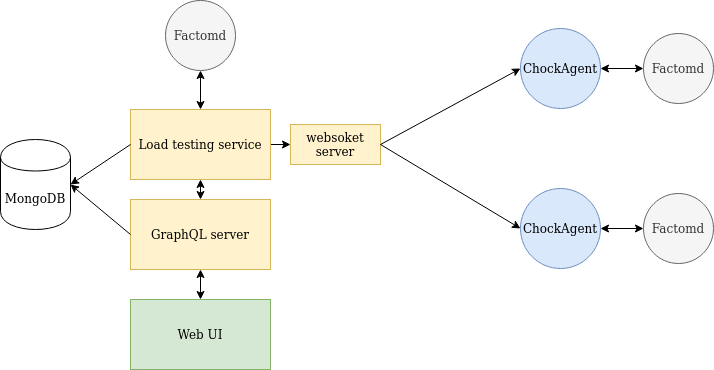ChockaBlock is a load testing tool for the Factom blockchain.
Technology used:
- Frontend: Vue.js + Vuetify (1.5.x) + Chart.js
- Server: Node.js, GraphQL
- Database: MongoDB
- Agent: Go
- server/agents communication: websocket
This repository contains the code for the GraphQL server, the web frontend UI and the websocket server to communicate with agents. Agent source code can be found here.
Note that ChockaBlock also has a dependency on https://fct.tools API to fetch authority set information.
Have a look at deploy.sh script for a basic way to deploy ChockaBlock and at the associated Nginx configs in doc/nginx-config.
To build the frontend:
npm run buildThe frontend will be built in a dist folder. It needs to be moved to www folder which is where the server app is expecting to serve static assets from.
ChockaBlock is using MongoDB. It expects it to be on port 27017. We recommend using the MongoDB docker container:
docker run --name mongodb -p 27017:27017 -d mongo:4.1-bionicSee doc/database.md for information on the database structure.
A Factomd (testnet) node is expected to run on localhost with its API exposed on port 8088. This node is used to read the block information and also create chains.
Some environment variables need to be set before starting:
EC_ADDRESS=EsXXXXXXXXXXXXXX # EC private address used to create chains
JWT_SECRET=XXXXXXXXXXXXXXX # JWT secret for JWT based authentication (random string)
VUE_APP_GRAPHQL_HTTP=https://chockablock.luciap.ca/graphql # Apollo GraphQL configs
VUE_APP_GRAPHQL_WS=wss://chockablock.luciap.ca/graphqlThen to launch ChockaBlock, using PM2:
pm2 reload ecosystem.config.js --env productionThis will serve static files (UI) and GraphQL server on port 4000. Websocket server (for agents to connect to) is on port 4007.
This is a monorepo containing both frontend and backend. Folder server contains backend code (Node.js/GraphQL) and src contains the frontend code (Vue.js). See doc/database.md for information on the database structure.
Create a file .env at the root. Fill it with:
JWT_SECRET="5902964580"
EC_ADDRESS="Es32PjobTxPTd73dohEFRegMFRLv3X5WZ4FXEwNN8kE2pMDfeMym"You then need to credit the address EC2vXWYkAPduo3oo2tPuzA44Tm7W6Cj7SeBr3fBnzswbG5rrkSTD with some EC:
factom-cli importaddress Fs3E9gV6DXsYzf7Fqx1fVBQPQXV695eP3k5XbmHEZVRLkMdD9qCK
factom-cli buyec FA2jK2HcLnRdS94dEcU27rF3meoJfpUcZPSinpb7AwQvPRY6RL1Q EC2vXWYkAPduo3oo2tPuzA44Tm7W6Cj7SeBr3fBnzswbG5rrkSTD 1000000Launch local factom node and MongoDB:
factomd -network=LOCAL -blktime=60 # Run a local factom network with a 60s block time
docker run --name mongodb -p 27017:27017 -d mongo:4.1-bionic # Start local MongoDB Docker containerLaunch ChockaBlock frontend and backend in dev mode:
npm i # Install dependencies
# Run the following commands in parallel (separate terminals)
npm run serve:backend
npm run serve:frontendnpm run serve:frontend and npm run serve:backend will handle hot reloading both for the frontend and the backend.
ChockaBlock UI is available at http://localhost:8080/ and the GraphQL playground is at http://localhost:4000/graphql.
You probably also wants to run a local chockagent to apply load: https://github.com/PaulBernier/chockagent#run-an-agent-locally-for-development
To create an admin user locally:
# Get a MongoDB shell in the Docker container
docker exec -it mongodb bash
mongo
use chocka
# Create an admin user with 'admin' as password
db.users.save({name: "admin", password: "$2b$10$qfRebpOZcyXTFo0ZRnYBSedf.4RevfLhpQlOEj21JQJVvY6QSndpO", roles: ["admin"]})